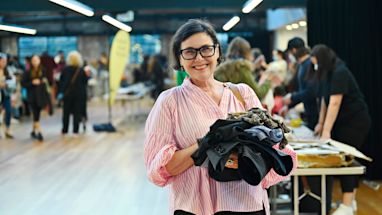Despite our best intentions, we all get plastic recycling wrong sometimes.
A little bit of contamination is okay, but if enough of the wrong plastic is found in the yellow lid recycling bin, the whole lot can end up in landfill. Find out how to recycle different types of plastics properly.
1. Eliminate common culprits
Plastic bags are often found in the recycling bin and are a major cause of strife at the recycling plant. Plastic bags can become tangled in sorting machinery, potentially causing breakdowns and even fires. They can also hinder the recycling process for other materials.

What to do
Good: Don’t put your recycling in plastic bags that then go in the yellow lid bin. Instead, use a container and drop your recycling loosely into the yellow lid bin.
Better: Say no to plastic bags altogether. Did you know lightweight plastic bags are banned in NSW? Use a box or reusable bag to hold your groceries instead.
2. Don’t be soft on scrunchable plastic
Soft plastics are usually wrappers and packaging such as bread bags, pasta packets and chip packets. Hard or rigid plastics are often containers like water bottles, ice cream containers, fruit punnets and shampoo bottles.
The difference? Only hard plastics can go in the yellow lid bin. Use the scrunch test if you’re unsure. If you can easily scrunch it into a ball, it’s probably a soft plastic.

Since REDcycle stopped collecting soft plastics in late 2022, major supermarkets have formed the Soft Plastics Taskforce to develop an alternative recycling solution. As part of this, select Woolworths stores in Sydney are currently trialling in-store soft plastics collection and recycling.
If you're unable to access one of these trial locations, you’ll need to put soft plastics in the red lid bin when you’re done with them. We don't accept soft plastics for recycling at our events and services.
What to do
Good: Try to reuse soft plastics before putting them in the red lid bin. Give ziplock sandwich bags a quick rinse and re-use them again for snacks. Larger bread bags can be reused as liners for small rubbish bins, such as your bathroom bin.
Better: Avoid buying products packaged in plastic wrapping. Shop at local markets or choose packaging that can be recycled easily.
3. Don’t get caught out by combined or composite items
Combined items, such as newspapers that come wrapped in plastic, can’t be recycled as is. Take the wrapping off before you recycle the paper.
Composite items are packaging made from a mix of different materials – say, cardboard and plastic or aluminium. Unfortunately, the materials can’t be easily separated, meaning that composite items are not recyclable. Put them in your red lid bin.

What to do
Good: Separate recyclable materials like cardboard or paper from soft plastics and other contaminants and put them in the right place. For example, clean paper goes into the yellow lid bin, soft plastic wrapping goes in the red lid bin.
Better: Avoid combined and composite items like plastic-wrapped publications or single-use coffee cups, which have cardboard on the outside and plastic lining on the inside.
Take a reusable cup to coffee shops.
Where possible, choose products packaged in recyclable materials.
4. Be aware of what looks like the recycling triangle

The chasing arrow symbol may look like a recycling symbol, but it’s not. The number inside the arrow is an international plastic code and refers to the type of plastic the product is made from, not whether it can be recycled in your yellow lid bin.
To help you figure out how to recycle or dispose of an item, check the packaging for the Australasian Recycling Label symbols. This label is being rolled out over time, so not all items have this label yet.
If you can’t see the Australasian Recycling Label, ask your local council if an item is recyclable. The rules are different depending on where you live. If in doubt, it’s better to place an item in the red lid bin to avoid contamination.
What to do
Good: If you live in the City of Sydney’s area, check our website to learn more about recycling and what you can and can’t put in the yellow lid bin.
Also remember you can test for soft plastics using the scrunch test mentioned in point number 2.
Better: The best way for you to reduce the amount of waste that goes to landfill is to avoid packaging. No matter how wonderful your recycling efforts are, reducing consumption is the ultimate goal.
Published 1 November 2022, updated 3 July 2025



